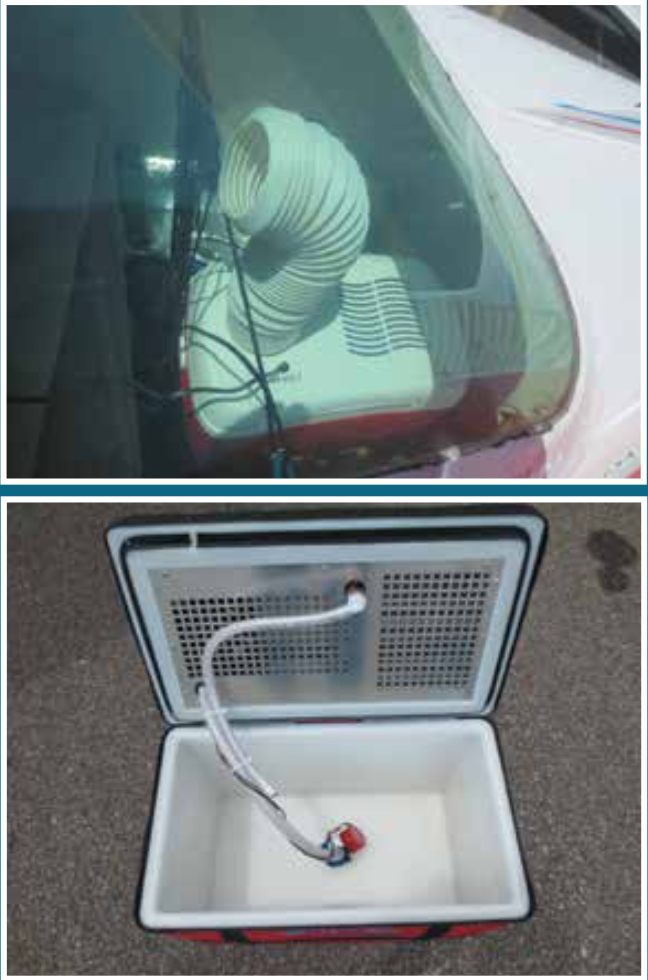With prices for installed aircraft air conditioning systems at $30,000 and climbing, it’s not surprising that owners are looking for less expensive cooling options. One we’ve explored is a portable aircraft cooler made from modern ice chests that uses a fan to blow air across a heat exchanger full of cold water from ice—never dry ice—to circulate cool air through the cabin.
After testing a few types on hot days we came to the conclusion that for a pilot who is willing to deal with getting ice and water to the unit and load it correctly, then lift as much as 65 pounds and maneuver the unit it into the baggage compartment or back seat, and having reasonable expectations as to the volume of cool air produced, the units do a pretty good job. After all, one pound of ice only provides 144 BTUs of cooling versus 7000 to 15,000 BTUs from installed air conditioners.
The are not “swamp coolers”—they do not add humidity to the air. None of the water—or its vapor—that goes through the heat exchanger is injected into the cabin. In our tests the coolers all put out air at 48 degrees F.
The upper photo—shot through the rear window of a Cessna 210—is of a B-Kool unit in the baggage compartment. The cooling duct is positioned to blow air forward over the back seat.
We found that realistic use of a portable air conditioning unit was for taxi, takeoff and climbout to more moderate temperatures at altitude. It is then shut off (although some have a “fan” mode), to be turned on during descent and used through landing and taxiing to parking. Depending on the size of the unit—how much ice it will hold—cooling time is between two and four hours. The lower photo is of the inside of an Arctic Air Pack 52 Quart unit. As with all of the units we surveyed, it uses a marine bilge pump to circulate water that has been cooled by the ice in the unit through a heat exchanger built into the lid where a fan blows cool air through one or two ducts into the aircraft.
The units are powered by the aircraft’s cigarette lighter and are available for 12- and 24-volt systems (some offer battery packs). The units are switched on and off either with a switch on the power cord or via an optional remote control.
In use, the bilge pump must be submerged in water for it to work. Just hauling ice and loading it into the cooler isn’t enough; depending on the unit, a minimum of a pint to two quarts of water is required.
When considering a purchase, knowing the dimensions of the unit is essential. Whether it will go through the baggage door or a cabin door mattered in our testing. Lifting a loaded cooler through a baggage door wasn’t bad—getting it through the cabin door and over the seats into the baggage compartment was just plain unpleasant.
Two of the units we tested had to be turned on their side to get through the baggage door. Make sure that it doesn’t leak before doing so. Ask us why we know.
Some models offer a pump-out feature that allows the bilge pump to pump the water out of the unit while it is still in the airplane. The ramp gets wet instead of the pilot who is trying to wrestle 60 pounds of sloshing cooler through a baggage door. We really like that option.
Our survey of the current portable aircraft coolers found four suppliers. The units vary in size.
B-Kool (www.b-kool.net) offers one cooler size; the price range—$299 to $429—is dependent on whether it is a 12- or 24-volt unit and whether it includes a remote off/on switch. It has a pump-out feature. When we tested coolers some years ago, this was our favorite because of its ease of use.
Arctic Air coolers (www.arcticaircooler.com) come in a wide variety of sizes from 30- to 52-quart capacity, with one or two ducts and one or two fans. Prices range from $815 to $905. They have a pump-out feature. We tested the 52-quart model and found that it could hold 40 pounds of ice, bringing the loaded weight to 63 pounds.
During our most recent market survey, we found two other brands of portable coolers at Aircraft Spruce (www.aircraftspruce.com): Aircraft Climate, with prices from $1195 to $1595, and Icebox, with prices from $545 to $649.





